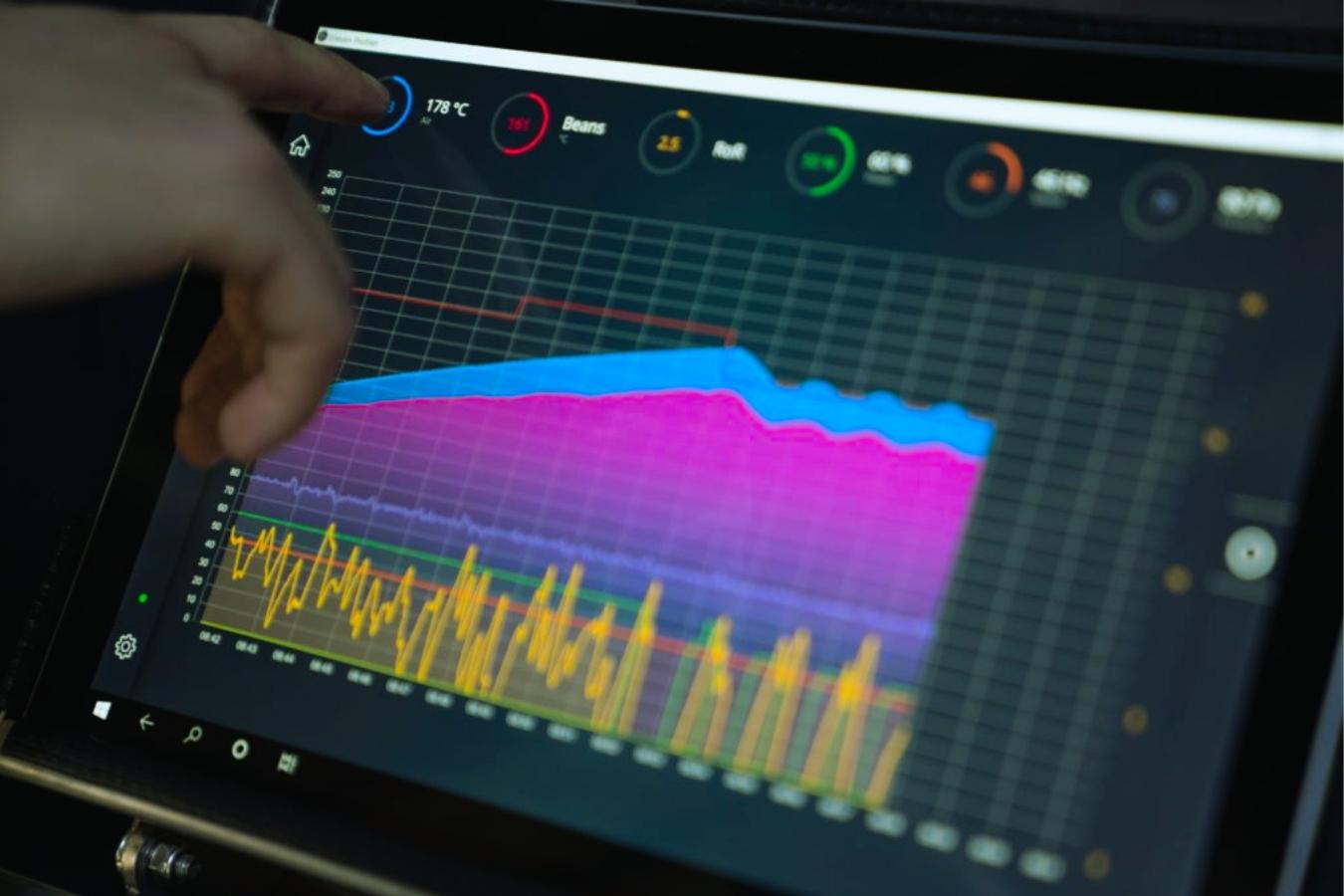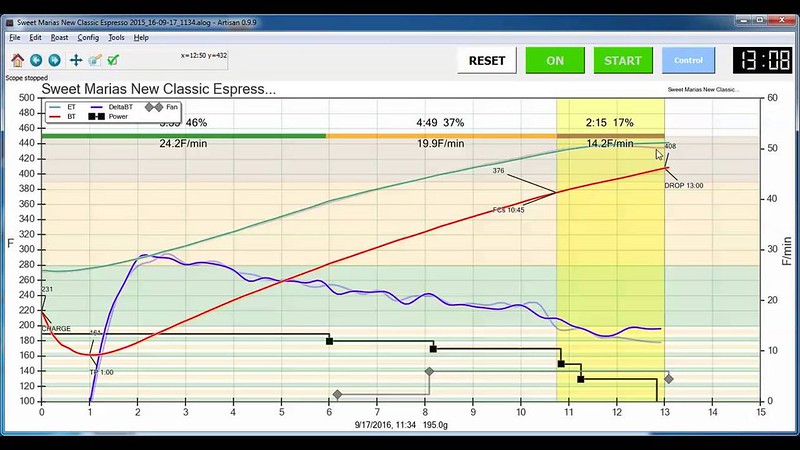
Roast Profile – Considered as a “diary” recording all changes that occur during the roasting process of coffee. Simply put, if the Flavor Profile of a coffee tells you the flavor characteristics – taste, aftertaste, acidity, sweetness, fullness, balance… of a coffee. any type of coffee. The Roast Profile is a “process record” that records the time, temperature, and adjustments made during the roasting process to bring about a certain flavor result.

First of all, I would like to emphasize that; Roasting coffee is by no means easy, “on the surface” is simple but internally is much more complicated, and becoming a great roaster will require dedication, practice, and constant experimentation. This helps you mentally prepare for the following “hard to swallow” knowledge:
What is Roast Profile?
Coffee roasting is the process of heating raw coffee beans for a period of time. This familiar concept reminds you of the two main factors that need to be controlled throughout the roasting process: time and temperature. Every small change in either variable will make a huge difference. And so you need a complete record of these changes – the Roast Profile (or Roast Profiling).
Essentially a Roast Profile is a “process record” that records what happened during roasting, what adjustments were made, and what effects happened to the flavor.
There are many ways to record a Roast Profile . Manually you can draw a table by hand as below, or with data logging programs such as Cropster , Roast Log , Artisan, Roastlogger, Roastmaster, Coffeesnobs, ..
The use of computer programs is showing greater efficiency in building Roast Profile. Basically, you only need a roaster, a sensor reader system, and a computer with an Internet connection to completely automate the data recording process. Moreover, modern programs allow you to make direct adjustments during the roasting process of temperature and time parameters, set the optimal configuration for each type of coffee… and countless other features, free of charge. is that you have enough money to buy a smart enough software.
Why is Roast Profile needed?
You can roast, and so on, roast each batch of coffee until it’s perfect, that’s what many people do!
The above suggestion is correct if you keep your roasting steady in the family size. However, have you ever wondered how Starbucks can roast hundreds of tons of coffee per year, with ingredients imported from dozens of countries, and still ensure consistency in taste? And we can summarize some of the advantages that Roast Profile brings as follows:
- Help you better understand the physical changes of the roasting process, understand the roasting cycle and the ability to develop the flavor of coffee. This is like a map that tells you what stage your coffee beans are in on their flavor transformation journey.
- The equipment parameter records give you a thorough look at the performance to get the most out of the roaster.
- And most importantly, the Roast Profile helps you maintain quality consistency on each roast, a “record” that helps you understand what needs to be done with a certain coffee, or a flavor requirement. determined.
On the other hand, Roast Profile is a general trend and also contributes to the sustainability of the coffee industry, with the third wave of coffee and the increased demand for enjoying high quality coffee, different varieties. Specialty Coffee needs to be “processed” and roasted in a more scientific way to best exploit the potential flavors. Add to that the public demand for transparency in the coffee chain (like do I need to know how my coffee is roasted?) promoting awareness of the importance of the Roast Profile.
The basics of Roast Profile?
Of course, you can’t achieve the comparative effect, if you start taking notes about Roast Profile like journaling, and in your own way. You need a system of indicators to track in each roast, so that you can then compare and see the difference in results on each change. For a Roast Profile to be really useful, we need a frame system with two main parts as follows.
Input variables – Before roasting starts
These are the basic parameters to have before, and while you roast a batch of coffee, including:
- Coffee volume
- Coffee bean moisture
- Grain size
- Weight per batch of roast
- Environmental conditions of the roasting room such as temperature, humidity, etc.
- Install and adjust air flow (if applicable)
- Install and adjust heat source (if any)
- Adjust drum speed (if any)
- Cooling time
Changes that occur during roasting
This is the most interesting and also the most important part of a Roast Profile, because based on these changes, you will get different results from which you can visualize your “roasting journey” through. How are the developments?
- Roasting start temperature
- Rate of Rise – RoR (Rate of Rise) represents the increase in temperature over time,
- All color changes at the start of the first crack
- Time to appear and finish the first crack (First crack), along with temperature
- Time between first and second crack
- End time, total roasting time
- Weight after roasting
- Moisture loss (calculated by weight of coffee beans before and after roasting)
- Color after roasting
Roast Graphs – Roast Graphs
There are a lot of parameters that need to be constantly monitored before and during roasting, and thankfully you don’t have to keep track of every single one. Usually computer programs will receive data from the sensors in the roaster and calculate it into a graph in real time. There are different types of graphs that represent variables ranging from machine temperature, grain temperature, pressure, air convection.. All of these are collectively known as Roast Graphs , based on On the changes on the graph you can imagine how your “roasting journey” has gone through.
In a nutshell, there are only so many essential parameters for a beginner. But when a level of professional perfection is combined with enhanced personal experience you will find that there are even more measurements and parameters before, during and after each roast. Looking at these lists and comparing different roasts will help you decide what measurements and adjustments you can make to impact the final quality – that’s how we get the most out of it. Roast Profile fruit.

How to apply Roast Profile
If you roast coffee by manual method or roasting equipment does not have the ability to adjust air, convection current, adjust temperature or roasting drum speed, etc., the problem is whether Roast Profile is really useful. ? Of course yes, to the fullest extent you can still adjust the amount of coffee per roast, as long as you focus on the results you get after each experiment.
The above seems contradictory to the fact that you have a sophisticated system with many sensors and devices that are capable of optimally fine-tuning each roast. In this case changing too many parameters at once on each roast will put you in a matrix with no exit. And so let’s start tweaking the parameters one by one, keeping the rest of the variables fixed, to see which changes make a significant impact on the final flavor quality.
In the end, the biggest lesson from Roast Profile is to collect as much data as possible and apply only what is necessary, not too dependent on it. Numbers help you systematize measurable factors to achieve the best results. But not every indicator is measurable, and can be measured with absolute precision. After all, coffee and everything related to it is an art so don’t lose your artisan part by mindless numbers.
Reference source:
- www.legacy.sweetmarias.com/ Roast Profiling
- www.cafeculture.com/


